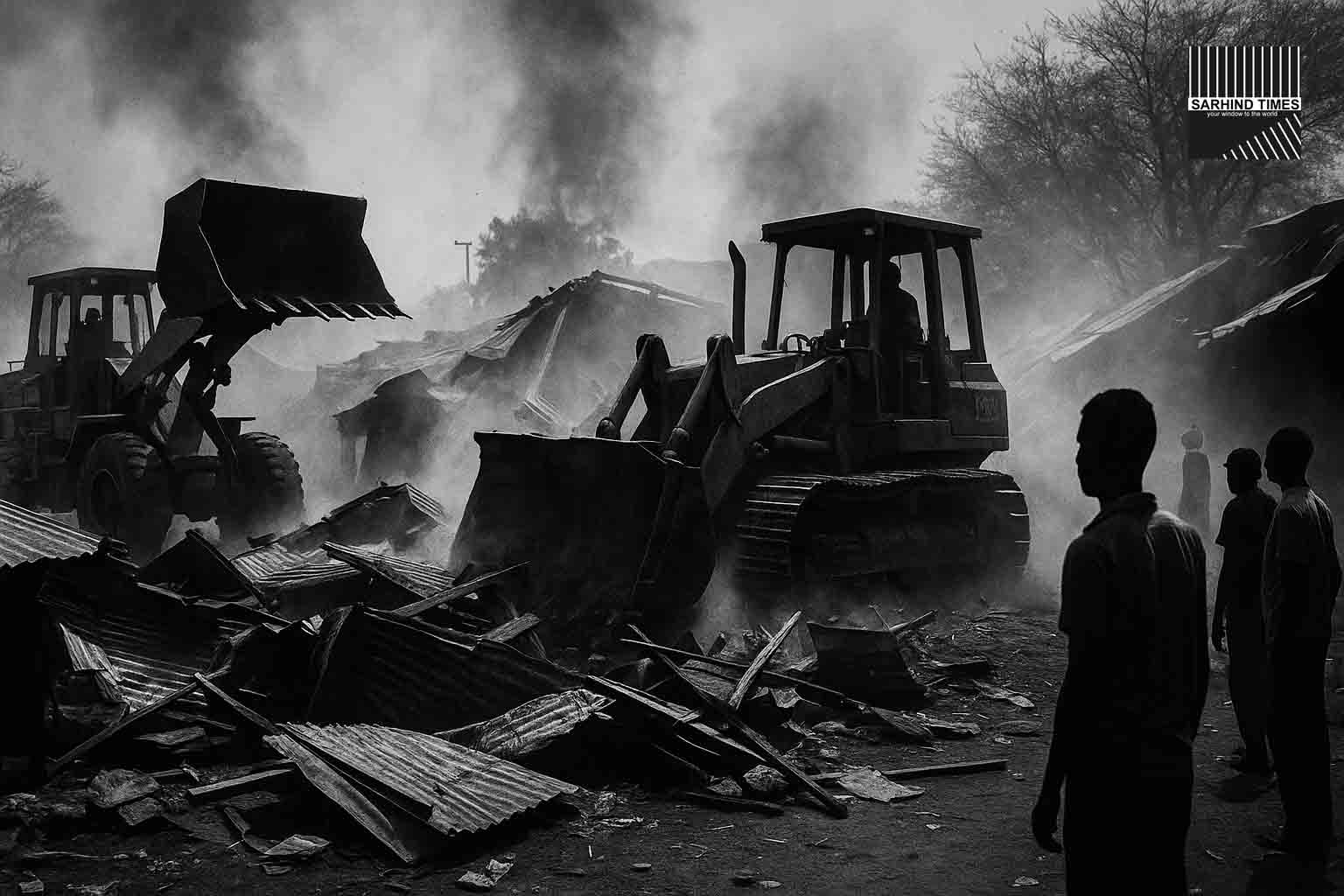Gurugram, 09 October 2025 — In a large-scale civic enforcement action, the Haryana Shahari Vikas Pradhikaran (HSVP) carried out a demolition operation in Sector 12A market, Old Delhi–Gurgaon Road, pulling down 172 illegal huts built on government land. The drive, which began early in the afternoon and extended into the evening, proceeded despite spirited opposition from many residents, who sat in protest or attempted to block bulldozers. Police were called in and a few protesters were briefly detained. Officials said the move aims to reclaim public land, ease congestion in a busy corridor, and assert urban governance in the face of chronic encroachment. Traders welcomed the decongestion but urged that the authority follow through with sanitation, lighting, and fair rehabilitation for residents displaced. Rights groups cautioned against abrupt evictions and demanded clear relocation or support pathways for those genuinely needy. HSVP stated that 86 huts, belonging to previously validated beneficiaries, will be spared until alternate flats under the Aashiyana scheme are allocated; the remainder were targeted for removal. The drive highlights perennial tensions in Gurgaon between rapid urbanization, land rights, developmental imperatives, and welfare obligations.
📋 The Demolition Drive: Process, Conflict & Claims
Timeline & Execution
- The demolition began around 12:30 p.m. and continued into late evening.
- The enforcement team was led by RS Bhath, district nodal officer (enforcement), and Rakesh Saini, Estate Officer I, HSVP.
- Residents, including women and children, gathered in numbers, staging verbal protests, sitting in the pathway of machinery. Some attempted to physically block the operation.
- Police presence was significant; a minor cane charge was carried out, and a few protesters (including women) were detained to prevent escalation.
- The drive proceeded after the initial resistance, with the enforcement team proceeding to remove huts and structures.
Numbers & Distinctions
- HSVP officials stated approximately 258 huts existed in the zone; out of these, 86 huts have been recognized as belonging to residents validated by past district committee processes. These 86 are to be spared for now until alternate housing is allotted.
- The remaining 172 huts (i.e. those without validated claim or deemed illegal) were demolished today.
- The 86 recognized hut owners, officials said, will continue to remain until flats under the Aashiyana scheme (Sector 47) are allotted to them.
- HSVP claims that adequate notices were issued in advance, giving time to vacate.
- Officials also clarified that promises or court undertakings regarding allotment have been longstanding, but legal and administrative bottlenecks have delayed actual possession transfer. Critics and occupants allege no one among the 86 has yet genuinely received a flat.
Resistance, Claims & Political Presence
- Congress leaders, local party workers, and residents assembled at the site demanding a 10-day reprieve before demolition.
- Protesters alleged that economically weaker hut dwellers, many of whom have lived in the area for decades, are being targeted without rehabilitation. They accused HSVP of failing to deliver promised flats under earlier court undertakings.
- Some locals claimed the structure count has grown over time from early decades: in 2010, there were ~86 huts; now, encroachments have increased to ~258, they contend.
- Shopkeepers in the adjacent market said that over time the hutments had encroached into market space, adding to congestion and reducing footpaths and road width.
- HSVP and enforcement officers maintained that the 86 validated hut owners will be protected and that illegal encroachment cannot be tolerated, especially on HSVP land.
📐 Historical Context & Similar Civic Actions in Gurgaon
Encroachment Drives & Land Recovery
Gurgaon has periodically seen anti-encroachment operations across sectors and markets:
- In Sector 21, HSVP cleared ~15 acres of land formerly occupied by scrap godowns and tin huts in 2025.
- In Sector 57, HSVP in April 2025 demolished encroachments over a prime 3-acre plot, clearing several hundred huts and structures.
- In past years, Banjara Market (Sectors 52A/53) saw demolition of makeshift shops and huts under HSVP enforcement drives.
- Earlier, in 2020, DTCP had demolished illegal developments in Sector 12A and Carterpuri area, removing plinths and boundary walls in unauthorized colonies.
These episodes reflect a recurring pattern: land made for public or future infrastructure is encroached, tolerated for years, and later reclaimed via enforcement.
Institutional Mechanisms & Enforcement Structure
- HSVP maintains an Enforcement Wing that tracks encroachments using formats M-1 and M-2 monthly, monitors removals, and flags lapses in lower units.
- When enforcement is triggered, Estate Officers, district nodal officers, duty magistrates and police support are mobilized, often after legal notices.
- The practice of recognizing “validated hut owners” (e.g. the 86 in this case) and sparing them until alternate housing is allotted is a pattern seen in other drives, reflecting an attempt to balance enforcement with some protection for longstanding dwellers.
🔍 Analysis: Benefits, Challenges & Contention Lines
Intended Benefits & Justifications
- Reclamation of Public Land & Urban Order
Removing illegal hutments reclaims space for planned roads, footpaths, drainage, and markets. The corridor along Old Delhi–Gurgaon Road is a critical artery, and encroachments lead to congestion, obstructed pavements, and illegal commerce. - Rule of Law & Deterrence
The drive sends a message that encroachments, even longstanding ones, are not immune from enforcement, reducing incentives for future illegal occupation. - Infrastructure & Sanitation Gains
Clearing huts can make way for improved sanitation, drainage, street lighting, waste management, and civic infrastructure, benefiting the broader community and traders. - Urban Planning Integrity
In a rapidly expanding city, allowing sprawl and unauthorized structures undermines master plans, zoning control, and municipal authority.
Core Challenges & Points of Contest
- Rehabilitation & Social Justice Gaps
— Critics argue that removal without assured, timely relocation leaves vulnerable families homeless. The delay in actual flat allotments under the Aashiyana scheme is a sore point.
— The “validated” 86 hut owners are supposed to be protected, but none have yet moved into allotted flats, critics say — pointing to administrative lethargy or broken promises.
— Many of the dwellers claim 40–50 years of residence and lack of alternate housing options. Their dispossession, they argue, amounts to state neglect. - Ad hoc Implementation & Inconsistent Policy
— Enforcement has often been selective or uneven across sectors; some encroachments persist unchallenged for years while weaker groups are targeted.
— Political interference or pressure can stall allotments or delay protections promised to hut dwellers.
— Differences in legal backing (court orders, land titles, beneficiary lists) complicate the operation. - Legal & Court Oversight Risks
— Protests and legal challenges may stall or reverse demolition if lapses in due process or notice emerge.
— In Gurgaon itself, the Supreme Court has stayed demolition drives in DLF phases 1–5, ordering status quo pending hearings.
— If courts find procedural violations or inadequate rehabilitation, subsequent liabilities or injunctions can follow. - Humanitarian & Ethical Dimensions
— Forced evictions can disrupt livelihoods, incomes, community networks.
— Inadequate notice periods, poor relocation allotments, and weak social support systems often compound injury to dispossessed families.
— Ensuring dignity, compensation, and minimal trauma must be integral to such drives—but in practice these often lag behind enforcement urgency. - Follow-up, Maintenance & Utility Provision
— After clearance, authorities must ensure basic services, street lighting, sanitation, drainage, and public safety infrastructure are installed.
— Without maintenance, reclaimed land may degrade or be re-encroached.
— Coordination between HSVP, municipal bodies and local civic agencies is critical in implementation.
🧩 Stakeholder Voices & Reactions
Authority / HSVP
- HSVP officials maintain the demolition is lawful, necessary, and supported by prior notices.
- They assert the 86 hut dwellers have valid claims and are being spared until alternate flats are allotted.
- The authority says legal and administrative delays have slowed flat allotments, but enforcement cannot wait indefinitely.
Residents, Protesters & Legal Counsel
- Some hut dwellers say they were given promises earlier but never saw actual benefits; they feel they are treated unjustly.
- Counsel for the dwellers has stated they will challenge the demolition in court, claiming false statements made in court to get demolition permission.
- Protesters demanded a 10-day moratorium so that alternative housing or due compensation can be arranged.
Traders / Market Users
- Traders in the 12A market cluster expressed relief that encroachments and huts that obstructed footpath and market flow are being cleared.
- Many asked HSVP to ensure after demolition the area is kept hygienic, with adequate lighting, pavements, waste disposal, and security.
Rights Groups / Civil Society
- Rights organizations have flagged that such civic drives must be accompanied by robust rehabilitation policies, compensations, grievance redressal and social support.
- They warn against using enforcement as a substitute for robust housing policy, calling for balanced approaches that protect the vulnerable.
🔭 What Happens Next & Risks to Watch
Key Indicators in Coming Weeks
- Whether allotments under Aashiyana scheme are progressively handed over to the validated 86 hut owners.
- The coordination of civic agencies (HSVP, municipal bodies) to restore hygiene, lighting, footpaths, drainage in Sector 12A.
- How remaining residents and protest litigants respond — court petitions, public protests, legal stays.
- Whether displaced families secure temporary or alternate accommodation and whether compensation or relief measures are in place.
- Monitoring of re-encroachment attempts after demolition, and enforcement responsiveness.
- Whether similar drives expand to other encroached sectors or markets, following this precedent.
Potential Risks & Scenarios
- Litigation / Stay Orders: Courts may stay further demolition or order restoration if procedural lapses are found.
- Humanitarian Fallout: Families without alternative housing may suffer displacement, loss of livelihoods, or social distress.
- Political Backlash & Local Opposition: Local leaders or parties may politicize the evictions, pressurize authorities, slow enforcement.
- Implementation Gaps: Reclaimed land may lie unused, or civic restoration may lag, resulting in open vacant stretches or dumping grounds.
- Encroachment Reversal: Without maintenance or guard, reoccupation by squatters is always a possibility.
#Gurgaon #HSVP #UrbanDevelopment #Encroachment
























+ There are no comments
Add yours